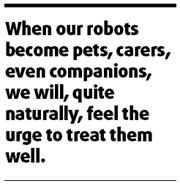A future of learning to live, love robots
London, 1977: the International Grandmaster chess player Michael Stean is losing to Chess 4.6, a computer program developed at Northwestern University, Illinois. Stean is steamed: he is losing. Chess 4.6 is, he says, "an iron monster". When finally he admits defeat, however, he does so with grace, declaring 4.6 a genius.

Whether we are leaving it all to the cat, or thrashing a car with a stick, we anthropomorphize as much of the world as we can. Twelve thousand years ago we took wild animals and fashioned them in our image: domestic cats have evolved babyish complexions to appeal to our love of cute.
Anthropomorphism, although apparently a sentimental tic, is central to what makes us human. A baby's realization that other people are more than animated furniture develops over time, prompted and reinforced by a pattern of exchanged glances. Long before children acquire this understanding (called theory of mind), they are fascinated by eyes, and by the direction of another's gaze. We become human only because, early on, someone treated us as human.















